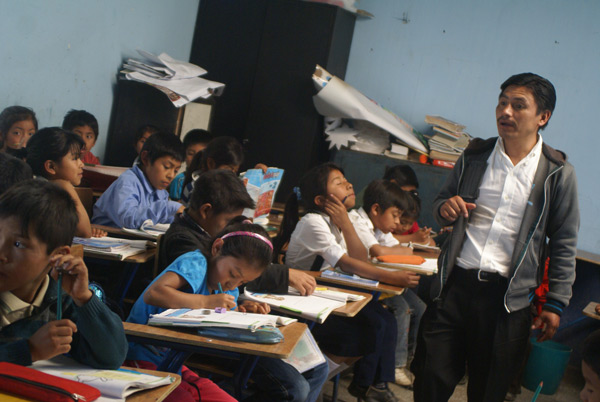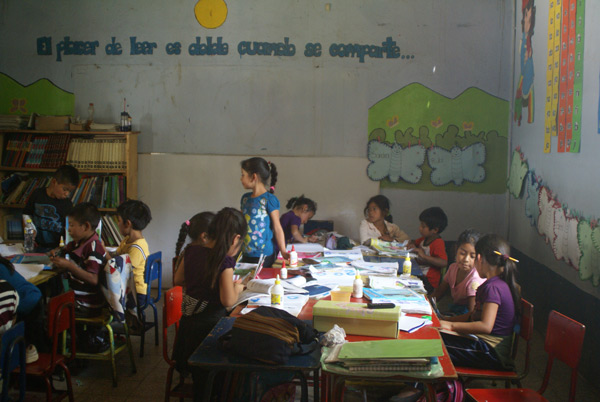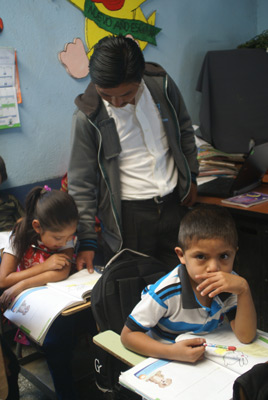Education in Guatemala Happy Teacher’s Day -June 25th-
Teachers have a particularly difficult job in Guatemala as few resources are allotted to public schools. In theory, education is free and compulsory through sixth grade.
Books, busing and uniforms are not free and result in higher drop out levels. Today, about 4 million children are enrolled out of a total population of 15.8 million people.
Education in colonial times was available to Spanish speaking boys at schools run by monasteries and girls and women at schools in convents. The Dominicans founded the first university in 1675, it was one of the first in the Americas. The religious orders also set up a school for the Maya chieftain sons. Liberal reforms by President Justo Rufino Barrios in the 1870’s brought a separation of Church and States and introduced public schools: primary school became free and compulsory. Modern subjects replaced theology when some religious schools became public. The Dominican University became public/national in 1875 and other reforms were carried out. President José María Reyna Barrios promoted education during his presidency (1892-1898) and provided scholarships to many Maya boys at the Escuela Normal de la Antigua. In 1897, due to an economic crisis, Reyna Barrios closed schools and the national university. President Estrada Cabrera reopened them in 1900 and added a strong curriculum of military studies. Other reforms came with the Arévalo government of 1944.
Education is improving with our current generation. Since the signing of the Peace Accords in 1996, significant advances have been made in providing schooling at the primary level (grades 1-6). The Ministry of Education reports that the percentage of children completing their primary education has increased from 39% in the early 1990’s to above 70% in 2006. The percentages are even better today, although the drop-out rate remains high. A closer look at education shows us that Ladino urban kids have more access to education and Maya girls have the lowest level of access. It is estimated that the country has an average 4th-grade educational level that clearly shows little access to secondary school for many kids.
The budget provided by the Guatemalan government is meager: 2.8% of the GDP spent on education with 56% of that for primary school and a mere 13% for high school. Education is clearly underfunded. While the current state of education is improving, less than 15% of all classrooms meet minimum standards for classroom space, teaching materials, classroom equipment and furniture. This percentage drops to 0% in the rural areas. Teachers remain underpaid and prefer teaching jobs in urban areas where they have access to higher education and less of a daily commute.
The school year, mid-January through mid-October, was based on the coffee crops, which made up to 98% of the economy (1870-1995). Today, 40% of the economy is in non-agricultural sector, and an estimated 60% of the jobs at an entry-level require computer skills as the Guatemalan economy is becoming more diversified. Illiteracy doesn’t work for our developing country.
One change that has been greeted by many is the inclusion of the teaching Mayan languages in school. While most of the schooling is conducting in Spanish, there are also 21 different Mayan languages taught in schools today – many as a second language. This inclusion promotes a better cultural understanding for Guatemala’s youth. Another change is the number of universities. The University of San Carlos remained the only university until 1961 with the founding of the University Rafael Landívar. Today, there are 15 universities throughout the country.
We wish all teachers a Happy Teacher’s Day on June 25th. The private sector continues to support you through NGOs as the Guatemalan private sector recognizes that education is a good investment for the country’s future. UNICEF agrees with us, if a student graduates from high school, they have a slim chance of living in poverty. Support a child’s education.
María Chinchilla Recinos, was a Guatemalan schoolteacher, born in Asunción Mita in the Department of Jutiapa.
In 1944, the schoolteachers submitted a request for an increase in salary to the country’s dictator, General Ubico, while students from San Carlos University called for the university’s independence.
Discontent increased to such a point that on 25 June 1944, some 300 women dressed in mourning embarked on a peaceful demonstration calling for freedom, democracy and the resignation of the dictator. Chinchilla, one of the demonstration’s organizers, was among those who were killed when the government sent out troops and the cavalry to put an end to the protest.
Chinchilla is now regarded as a martyr and national heroine, having brought about Ubico’s resignation five days after the demonstration.
On 6 June 1944, the Guatemalan teachers’ association resolved that 25 June would be celebrated annually as the Schoolteacher’s Day in memory of María Chinchilla Recinos.
Revue article: GUATEMALA INSIGHT
by Elizabeth Bell, author/historian. AntiguaTours.net
Photos by Mercedes Mejicanos




As a teacher myself, I can attest to the sacrifices made on behalf of students and their families. It is a noble profession!